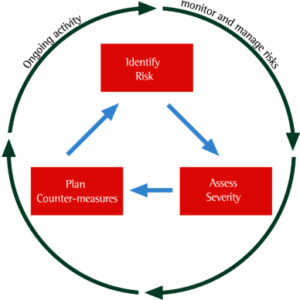Today let’s continue our Agile series, this time focusing on the notion of risk management in projects.
I’m sure we all recognize that managing risk is a big part of managing projects, but when we’re dealing with a DSDM Agile project, what framework exists to help us do this well?
For the Lowry application of DSDM Agile we start with referencing the diagram below and the following:

You’ll probably notice that this is similar to other risk assessment models you’ve seen, like those in the PMI and PRINCE frameworks. The reason for this is simple: it’s because risk, being common across all management frameworks, has to be identified, assessed, and planned for regardless of your management model.
So, in every project management framework you’ll find something like this to help you manage project risk. As an example, recently we had the pleasure of working through a customer’s risk-planning process for a project we are doing with them, and-you guessed it–these three topics of identify, assess, and plan were the focus.
When considering risk management, one key objective is to bring your team together—often through a facilitated workshop—to identify potential risks tied to a specific project. It’s important to distinguish true risks from lessons learned in the past so the team can stay focused on what really matters. While this can feel somewhat subjective at first, the process becomes more effective with practice. For organizations managing digital projects or IT initiatives, incorporating tools like mobile device management solutions can also help mitigate risks by ensuring secure and efficient handling of devices and data.
If you focus on risks that can truly disrupt your project, including those related to RFID technology, things that are both in and out of your control, you’ll come up with a pretty good list. Don’t do all three steps at once, but first get together a list of risks. Then work through identifying both the severity and the planned counter-measure for each risk.
If you do it this way, you’ll find yourself able to eliminate duplicate risks that maybe are just worded differently, etc., thus helping you ensure a good starting point for a working list. Remember, because this is an Agile project, you can always update the list if anything new should happen, or if you learn something new, which would warrant such an addition.
After you have your list of identified and documented risks, then go through them one by one and assess each risk on a scale of, for example, 1 to 3. Then, as you provide an assessment of each risk, document the counter-measures in case the particular risk you’re discussing actually happens.
In doing so, you’ll end up with a list of risks for your project that are identified, assessed for severity, and have a pre-built plan for dealing with the risk should it occur. One of the many great things about this is that then, because this is a group effort and the whole team is engaged, you’ll automatically reduce the potential for these risks to interrupt your project because everyone will be working to reduce their potential quite naturally.
As you can imagine, this is one of the great benefits of engaging in this risk management process when running an Agile project. Not only do you know what you’re dealing with regarding risk, but because of the natural collaboration built into the DSDM Agile framework, your whole team will be actively working to reduce risks at all times in everything they do. It really is a win-win for everyone when you’re properly managing risks in an Agile project.
So this is what risk management looks like when you’re managing risks in a DSDM Agile project. I hope you’ve found this helpful and informative. We’ll pick up from here in the next blog.
Thank you for your time today. Please let us know your thoughts and questions by commenting below. As always, you can learn more about how Lowry Solutions implements the Agile Philosophy, and is itself applying the Twelve Principles, in our whitepaper Discovering the Lowry DSDM Implementation Methodology. If you want more information on how we can help you with a specific challenge, contact us today.


